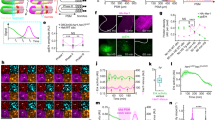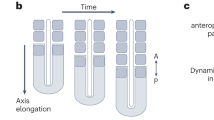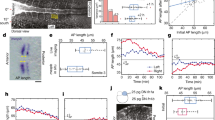Abstract
In vertebrates with mutations in the Notch cell–cell communication pathway, segmentation fails: the boundaries demarcating somites, the segments of the embryonic body axis, are absent or irregular1,2,3,4,5,6,7,8. This phenotype has prompted many investigations, but the role of Notch signalling in somitogenesis remains mysterious1,9,10,11,12. Somite patterning is thought to be governed by a “clock-and-wavefront” mechanism13: a biochemical oscillator (the segmentation clock) operates in the cells of the presomitic mesoderm, the immature tissue from which the somites are sequentially produced, and a wavefront of maturation sweeps back through this tissue, arresting oscillation and initiating somite differentiation14,15. Cells arrested in different phases of their cycle express different genes, defining the spatially periodic pattern of somites and controlling the physical process of segmentation1,16,17,18,19. Notch signalling, one might think, must be necessary for oscillation, or to organize subsequent events that create the somite boundaries. Here we analyse a set of zebrafish mutants and arrive at a different interpretation: the essential function of Notch signalling in somite segmentation is to keep the oscillations of neighbouring presomitic mesoderm cells synchronized.
This is a preview of subscription content, access via your institution
Access options
Subscribe to this journal
Receive 51 print issues and online access
$199.00 per year
only $3.90 per issue
Buy this article
- Purchase on SpringerLink
- Instant access to full article PDF
Prices may be subject to local taxes which are calculated during checkout





Similar content being viewed by others
References
del Barco Barrantes, I. et al. Interaction between Notch signalling and Lunatic fringe during somite boundary formation in the mouse. Curr. Biol. 9, 470–480 (1999).
Conlon, R. A., Reaume, A. G. & Rossant, J. Notch1 is required for the coordinate segmentation of somites. Development 121, 1533– 1545 (1995).
Evrard, Y. A., Lun, Y., Aulehla, A., Gan, L. & Johnson, R. L. lunatic fringe is an essential mediator of somite segmentation and patterning. Nature 394, 377–381 (1998).
Hrabé de Angelis, M., McIntyre, J. & Gossler, A. Maintenance of somite borders in mice requires the Delta homologue Dll1. Nature 386, 717–721 (1997).
Kusumi, K. et al. The mouse pudgy mutation disrupts Delta homologue Dll3 and initiation of early somite boundaries. Nature Genet. 19, 274–278 ( 1998).
Oka, C. et al. Disruption of the mouse RBP-Jκ gene results in early embryonic death. Development 121, 3291– 3301 (1995).
Wong, P. C. et al. Presenilin 1 is required for Notch1 and DII1 expression in the paraxial mesoderm. Nature 387, 288–292 (1997).
Zhang, N. & Gridley, T. Defects in somite formation in lunatic fringe-deficient mice. Nature 394, 374–377 (1998).
Jen, W. C., Gawantka, V., Pollet, N., Niehrs, C. & Kintner, C. Periodic repression of Notch pathway genes governs the segmentation of Xenopus embryos. Genes Dev. 13, 1486–1499 (1999).
Takke, C. & Campos-Ortega, J. A. her1, a zebrafish pair-rule like gene, acts downstream of Notch signalling to control somite development. Development 126, 3005– 3014 (1999).
Pourquié, O. Notch around the clock. Curr. Opin. Genet. Dev. 9, 559–565 (1999).
Jiang, Y. -J., Smithers, L. & Lewis, J. Vertebrate segmentation: the clock is linked to Notch signalling. Curr. Biol. 8, R868– R871 (1998).
Cooke, J. & Zeeman, E. C. A clock and wavefront model for control of the number of repeated structures during animal morphogenesis. J. Theoret. Biol. 58, 455– 476 (1976).
Palmeirim, I., Henrique, D., Ish-Horowicz, D. & Pourquié, O. Avian hairy gene expression identifies a molecular clock linked to vertebrate segmentation and somitogenesis. Cell 91, 639–648 (1997).
McGrew, M. J., Dale, J. K., Fraboulet, S. & Pourquié, O. The lunatic fringe gene is a target of the molecular clock linked to somite segmentation in avian embryos. Curr. Biol. 8 , 979–982 (1998).
Keynes, R. J. & Stern, C. D. Mechanisms of vertebrate segmentation. Development 103, 413–429 (1988).
Saga, Y., Hata, N., Koseki, H. & Taketo, M. M. Mesp2: a novel mouse gene expressed in the presegmented mesoderm and essential for segmentation initiation. Genes Dev. 11, 1827–1839 (1997).
Durbin, L. et al. Eph signaling is required for segmentation and differentiation of the somites. Genes Dev. 12, 3096– 3109 (1998).
Yamamoto, A. et al. Zebrafish paraxial protocadherin is a downstream target of spadetail involved in morphogenesis of gastrula mesoderm. Development 125, 3389–3397 (1998).
Haddon, C. et al. Multiple delta genes and lateral inhibition in zebrafish primary neurogenesis. Development 125, 359 –370 (1998).
Smithers, L., Haddon, C., Jiang, Y. -J. & Lewis, J. Sequence and embryonic expression of deltaC in the zebrafish. Mech. Dev. 90, 119–123 ( 2000).
van Eeden, F. J. et al. Mutations affecting somite formation and patterning in the zebrafish, Danio rerio. Development 123, 153–164 (1996).
Jiang, Y. -J. et al. Mutations affecting neurogenesis and brain morphology in the zebrafish, Danio rerio. Development 123, 205–216 (1996).
van Eeden, F. J., Holley, S. A., Haffter, P. & Nüsslein-Volhard, C. Zebrafish segmentation and pair-rule patterning. Dev. Genet. 23, 65–76 (1998).
Haddon, C., Jiang, Y. -J., Smithers, L. & Lewis, J. Delta-Notch signalling and the patterning of sensory cell differentiation in the zebrafish ear: evidence from the mind bomb mutant. Development 125, 4637–4644 ( 1998).
Holley, S. A., Geisler, R. & Nüsslein-Volhard, C. Contrl of her1 expression during zebrafish somitogenesis by a Delta-dependent oscillator and an independent wave-front activity. Genes Dev. 14, 1678 –1690 (2000).
Müller, M., von Weizsäcker, E. & Campos-Ortega, J. A. Expression domains of a zebrafish homologue of the Drosophila pair-rule gene hairy correspond to primordia of alternating somites. Development 122, 2071–2078 (1996).
Sawada, A. et al. Zebrafish mesp family genes, mesp-a and mesp-b are segmentally expressed in the presomitic mesoderm, and mesp-b confers the anterior identity to the developing somites. Development 127, 1691–1702 (2000).
Aulehla, A. & Johnson, R. L. Dynamic expression of lunatic fringe suggests a link between Notch signaling and an autonomous cellular oscillator driving somite segmentation. Dev. Biol. 207, 49–61 (1999).
Kimmel, C. B., Ballard, W. W., Kimmel, S. R., Ullmann, B. & Schilling, T. F. Stages of embryonic development of the zebrafish. Dev. Dynam. 203, 253– 310 (1995).
Acknowledgements
We would like to thank J. Campos-Ortega and S. Holley for sharing data before publication; E. de Robertis for the papc probe; Q. Xu for advice on time-lapse filming; and H. McNeill for comments. The work was supported by the Imperial Cancer Research Fund and by an EMBO Fellowship to Y.-J.J.
Author information
Authors and Affiliations
Corresponding author
Supplementary information
Rights and permissions
About this article
Cite this article
Jiang, YJ., Aerne, B., Smithers, L. et al. Notch signalling and the synchronization of the somite segmentation clock . Nature 408, 475–479 (2000). https://doi.org/10.1038/35044091
Received:
Accepted:
Issue Date:
DOI: https://doi.org/10.1038/35044091



